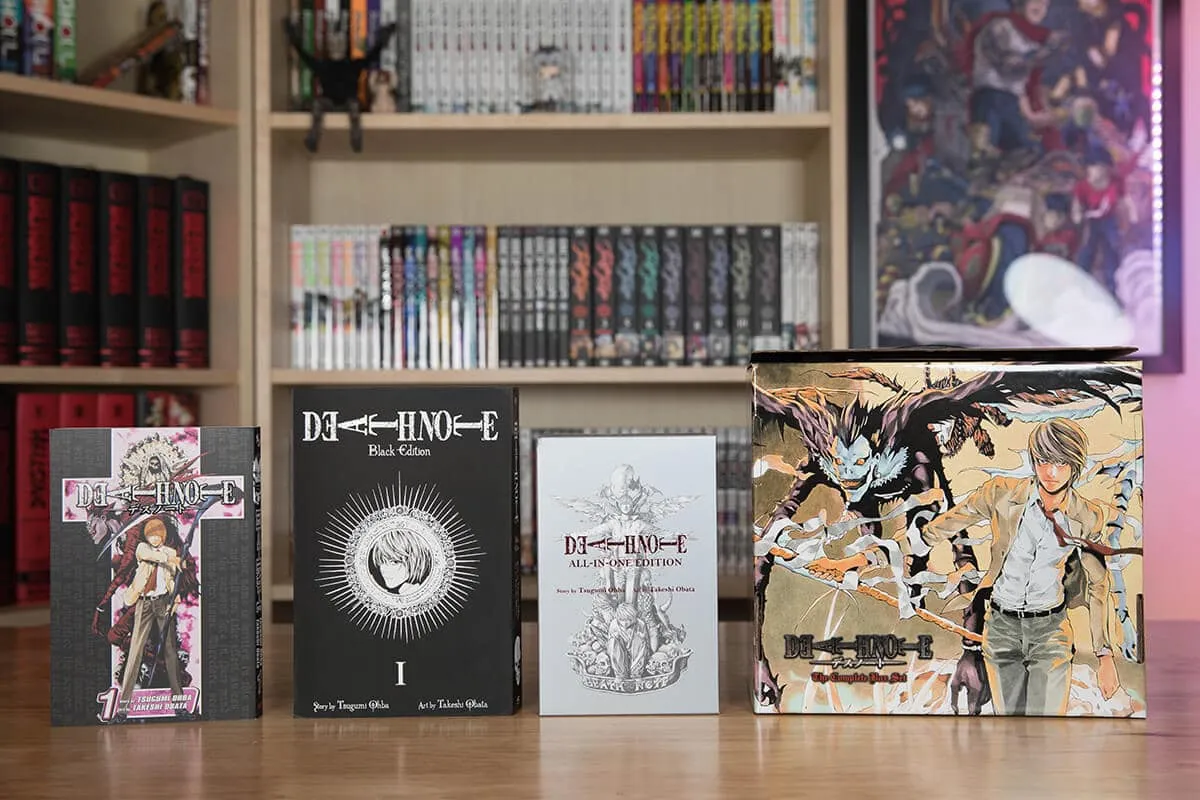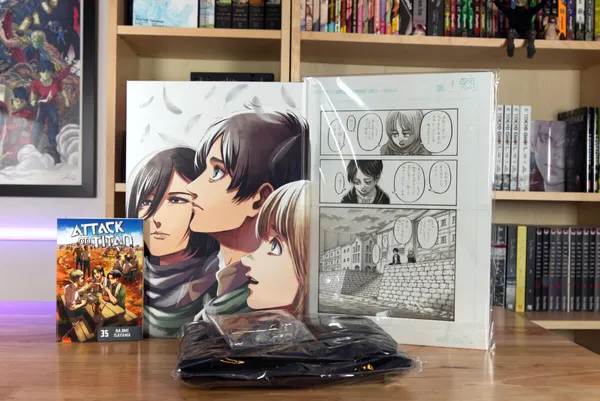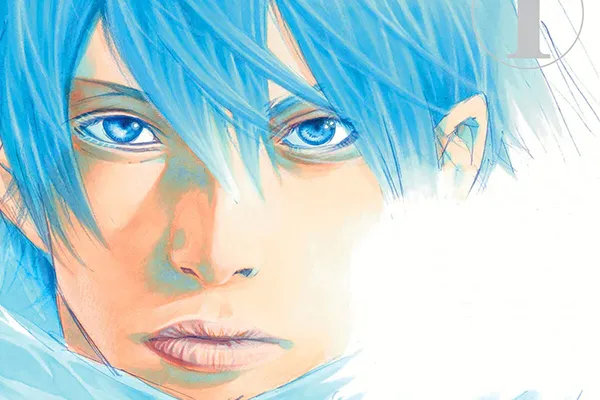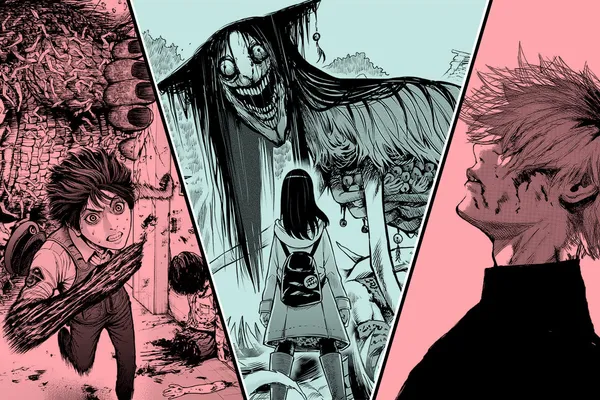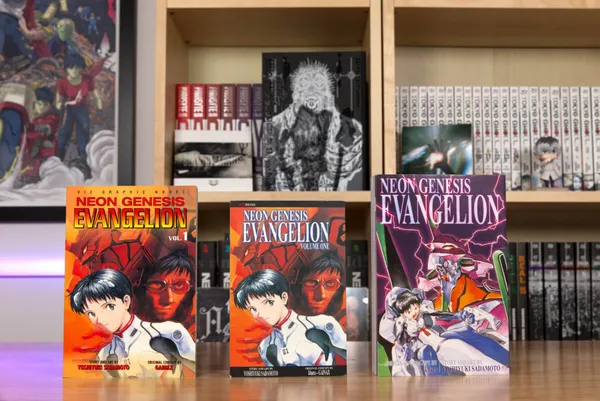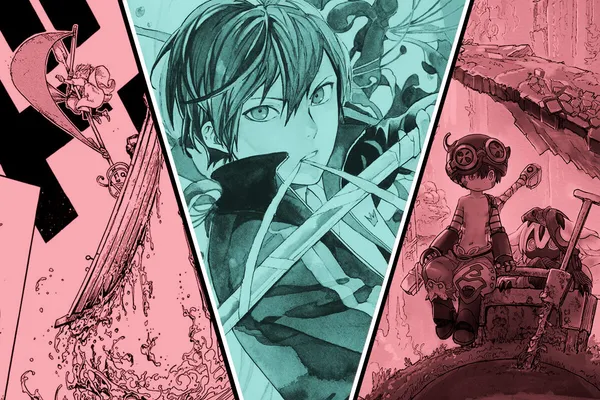Tsugumi Ohba and Takeshi Obata are two of my favorite manga creators, not only do I enjoy the series they’ve created together, like Death Note and Bakuman, but I also enjoy the series that Takeshi Obata has worked on with others like Hikaru no Go or All You Need Is Kill. Death Note is one of my all-time favorites of theirs as well as one of the best dark shonen manga you can read. When I went to collect the series for the first time, though, I was faced with a dilemma…
There are four different ways to fully collect Death Note‘s manga with English translation: The individual paperbacks, the Death Note complete box set, the Death Note Black Editions, and the Death Note All-In-One edition. With so many choices, I had a hard time deciding which one to go with. To help others who may be facing this same issue, I went out and bought every single Death Note manga edition to find out which one is the best.
Before I get into the review, I wanted to mention that there’s a hardcover Death Note Collector’s Edition of Volume 1 that you can also shop as well. Since only the first volume of Death Note was released in this format, I left it out of the comparison, but I wanted to mention it in case any of you are interested in checking it out.
All of the images in this post are of the actual products themselves. To be as comprehensive, accurate, and helpful as possible, I read each edition and compared them side-by-side to see how they differ in terms of quality, size, design, readability, extras, and more!

How many volumes of Death Note are there and how many volumes are collected in each edition?
12 individual volumes fully collect Death Note with English translation. The Death Note manga box set collects all 12 volumes of the series. The Death Note Black Editions are 2-in-1’s, so they collect the series in six volumes. The Death Note All-In-One Edition, much applicable to its name, collects all 12 volumes of Death Note in one edition.
Size and Shelf Space
The smallest format is the Death Note All-In-One Edition. Most listings describe it as a “monstrously large edition,” but the only thing that’s monstrous about this edition is its thickness at a whopping 3.2in thick. Height and width-wise, though, it is the smallest edition in terms of size.
The individual volumes are in the middle, while the Death Note Black Editions are the largest format of Death Note to release so far. They are 8.40in tall whereas the individual paperbacks are 7.5in tall.
With the All-In-One being a compiled edition that collects all 12 volumes in one, it saves you the most space on the shelf by far, only taking up 3.2in of shelf space. In comparison, the individual volumes take up around 9.6in while the Death Note Black Editions take up around 8.4in on the shelf.
What’s the cheapest way to collect Death Note?
The individual paperbacks retail at $9.99, the Black Editions retail at $14.99, the All-In-One Edition retails at $49.99, and the Death Note Complete Box Set retails at $114.99. All of those prices are in USD.
I know that the Death Note manga box set and some of the select volumes of the individuals and Black Editions have been flickering in and out of stock, so it has been difficult to fully collect the series, but please don’t pay crazy aftermarket prices for the box set, or any of these editions for that matter. Death Note is a highly popular and best-selling series, so they will all restock eventually.
With that all taken into consideration, the cheapest way to fully collect Death Note is through the All-In-One Edition. The second cheapest way to collect Death Note is the manga box set and the most expensive way is the individual paperbacks. All of the prices I listed above are full retail, but you can find them for even cheaper prices on sites like Amazon.

Design
The covers of the Death Note individual paperbacks have the same artwork as the Japanese volumes. The Death Note logo is glossy, but the rest of the cover has a slightly matte feel, not nearly as matte as the Black Editions though. They carried this over on the spine. Each volume’s spine features the artwork of a different Shinigami.
The Black Editions are paperbacks too, but they are much more minimalistic in terms of their design, which some may or may not like. They have the Death Note logo at the top as well as portraits of the characters in the center of the editions. The covers are matte, both the front and back. Interestingly enough, though, the spines are glossy.
All six spines feature a similar design with the Death Note logo and skulls at the bottom with the volume number written in Roman numerals on them. With similarly designed spines, they look more uniform on the shelf than the other editions do. The edges of the pages are black as well, which is unique to the Death Note Black Editions.
I also want to note that the covers of the Black Editions mark up easily, whether it be with fingerprints or dust. They also scratch easily if you aren’t careful and since they are black as well as matte, scratches or any imperfections stand out, so they require more care than the singles.
The All-In-One’s design is also simplistic. The edition is black with a graphic on it that makes it look as if it’s been scratched and distressed. There’s an image of Ryuk adorning the top of a cross in its center. The spine says Death Note All-In-One edition and it has a minimalistic look to it.
The box of the Death Note All-In-One Edition, however, has a nice design with black and white artwork on all sides. The front has the artwork seen on Volume 12 of the singles and then there’s artwork of Ryuk that wraps around its side to the back. The box itself is metallic silver and the metallic red foil text is inset into the box. When kept in its box, the All-In-One looks great, but out of it, the edition itself is my least favorite of the three.
Much like the Death Note Black Editions, the All-In-One needs to be handled with care. Because of its size and the fact that it’s paperback, the covers are prone to denting, and when read, it’s hard to get the edition back into its box, so be careful when doing so.
As far as the Death Note manga box set’s design goes, it features some of my favorite artwork. It has artwork of Ryuk and Light, the other Shinigami on its sides, and a metallic silver Death Note logo on the front.

Print and Page Quality
Takeshi Obata uses a lot of black in his artwork but he uses a lot of negative space as well in Death Note. His artwork has a lot of contrast, and contrast benefits from good-quality printing.
Every edition of Death Note aside from the All-In-One Edition is printed on off-white paper that has an eggshell-like texture. The All-In-One Editions are printed on white glossy paper, but the pages are extremely thin–So thin that they are see-through and you can see the panels of the pages underneath the one you are currently reading. It’s pretty bad, to the point where you can make out full details like Ryuk’s face and even read the text underneath on certain panels. So while the glossy, white paper is great for contrast, there’s a give and take here with the quality and thickness of the paper.
The print quality in the Death Note Black Editions is slightly better than what’s seen in the singles. The blacks are sometimes a bit too dark in the singles, so the mid-tones don’t stand out as much as they do in the Black Editions. You can make out more details in Takeshi Obata’s art in the Black Editions.
The larger format could be a reason as to why you can see more detail, but the contrast is slightly better in the Black Editions as well. Since the All-In-One has white glossy paper, they do have the sharpest contrast of the three, but since the art has been shrunk down into this smaller format, the details don’t stand out as much as they do in the Black Editions.
Cropping of the Artwork
Since they are different sizes, the artwork has been realigned to fit the different editions of Death Note. Because of this, some editions are cropped more at the top of the pages, while others are cropped less at the bottom of the pages. The All-In-One Editions are cropped the least at the bottom of the page, however, the individuals are the least cropped at the top of the page. The Black Editions are cropped the most at the top of the page and the individuals are the most cropped at the bottom of the page. Horizontally, though, the most cropped edition is the Black Edition and the least cropped edition is the singles.
To me though, the least cropped all-around are the individual paperbacks. While not the least cropped at the bottom of the page, they are the least cropped at the top. They are also the least cropped edition horizontally.
Translation and Sound Effects
I’ve heard some people mention something about an updated translation in the Black Editions, but the listing for the edition does not state this. I wanted to double-check, though, so I read the first Black Edition alongside the singles. I did not notice any differences in translation while reading, but I only have the first Black Edition right now. The translated sound effects were the same in all of the editions.
Another thing I saw people saying in reviews of the Black Editions is that the text of the speech bubbles isn’t aligned proportionally. This is something that persists in all editions of Death Note. Every speech bubble, where the text was off-center in the Black Edition, also occurred in the singles and the All-In-One Edition.
Readability
In terms of readability, the Death Note singles and Black Editions are the most enjoyable to read. They have little, if any, problems with gutter loss and they are lightweight. The All-In-One Edition however is the most cumbersome thing I’ve ever read.
It’s too small for how thick it is, and for that reason, it is extremely difficult to read comfortably. Because of this, the pages are difficult to read throughout as well. The All-In-One Edition has a big problem with gutter loss. Unfortunately, the All-in-One Edition is the worst in terms of readability and it is the least enjoyable way to read Death Note, but if you are looking for something compact that you can take on the road with you, I can see why it’s appealing.

Color Pages and Extras
Only one edition of Death Note has color pages: The Death Note Black Editions. This is one of the perks of picking them up. You can tell these pages were originally colored in the singles and All-In-One too, but they gray-scaled in these editions. Seeing the color pages in the Black Editions makes me long for a full-color release of Death Note with an English translation someday.
In regards to extras, the All-In-One comes with the one-shot special, C-Kira Story. This is the first time that this short story has been printed with an English translation. But, Viz is coming out with the Death Note Short Stories manga this year, which includes the C-Kira Story as well as others, so you can collect it that way as well.
As mentioned earlier, the Black Editions come with a few color pages, but this is the only difference I noticed in comparison to the singles in regards to extras. If you want to own the four-panel comics, the individuals and the Black Editions have them. The All-In-One Edition, however, does not.
The Death Note Complete Box Set comes with the 13th volume, also known as the How To Read Death Note volume as well as a “How to Use It” pamphlet, which outlines all of the rules when using the Death Note. The 13th volume is an incredible read and is one of my favorite additions to a box set, especially from Viz. It includes everything from commentaries and interviews with the creators to character profiles, a bonus manga chapter, and four-panel comics. It also comes with an L true name card inside it.
Final Verdict: What’s the best way to collect Death Note?
As always, it depends on what you are looking for. While I think you are going to get to experience an amazing series no matter what edition you choose, one may be a better fit for you. If you are looking for the cheapest way to collect Death Note, it’s the All-in-One Edition. Want to save the most space on the shelf or want something compact to take on the road with you? All-In-One Edition. Want the best readability? The singles and Black Editions.
Want the best extras? The Death Note manga box set. Looking for the most cost-effective way to collect the singles? Box set. Prefer the look of the original covers? Box set or singles. Like a more minimalistic design? the Black Editions. Best print quality? I would say the Black Editions here, because while the glossy pages in the All-In-One Edition give it the best contrast, the artwork is smaller, so they aren’t as enjoyable to read. Want an edition with color pages or prefer a larger format? The Black Editions.
What do I think, though? I’m stuck between the Death Note Complete Box Set and the Death Note Black Editions. Before I saw these all side-by-side, I would have said box set, but now that I’ve seen the Black Editions firsthand, I love them also. I’d still say your best and safest bet would be the box set if you are just now getting into collecting Death Note, but the Black Editions have won me over as well with their color pages, design, and larger format. You can get a closer look at the editions in my review on YouTube below!
Where to Buy Death Note
Learn more about each of these manga retailers and the pros and cons of buying from each.
